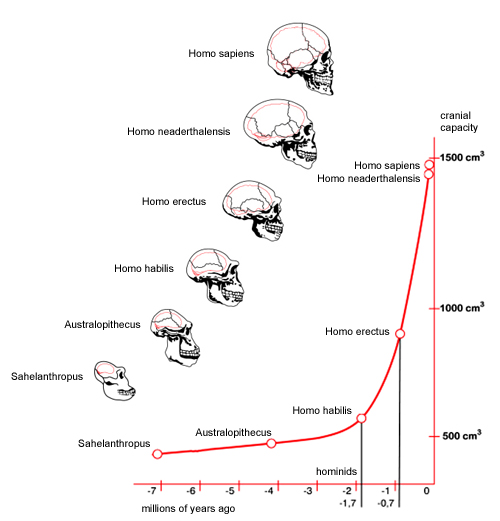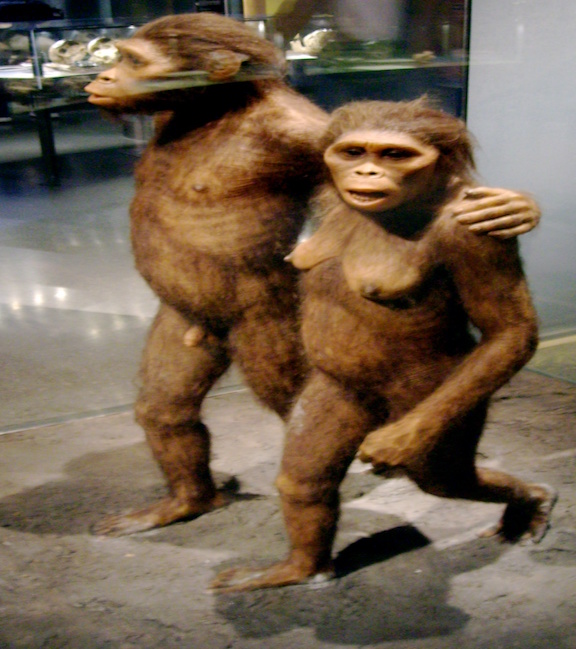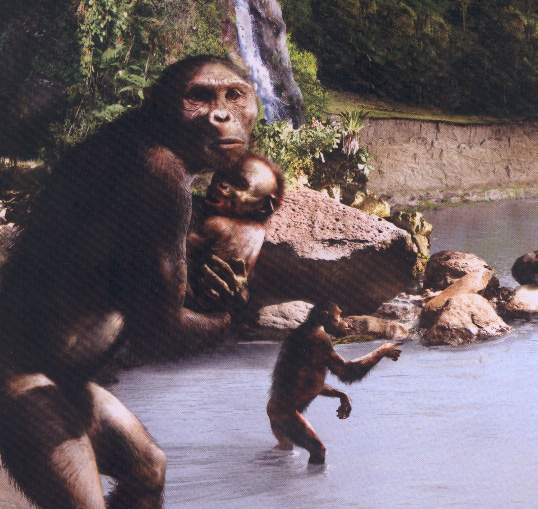Coming Home to the Pleistocene

by Paul Shepard
"The kind of intelligence and cunning needed by our primal ancestors to develop and survive as they did during the Pleistocene has been overlooked."
 p. 31.
p. 31.
"About two million years ago, at the border of the Pliocene and Pleistocene epochs, our first ancestors, Homo habilis, moved out toward the forest edge. Following corridors of riparian woodlands, where being partially arboreal, they could in time of danger seek sanctuary of the trees, they could also make excursions into open country."
p. 28.
"While the origins of the intelligent hunter gatherer go far back into the social structures of ancestral lemuroids and the vocality and vision of arboreal simians (monkeys), the break-out comes with savanna omnivory; now intelligence was fostered among bipedal scavengers carrying tools with cutting edges and finally cooperating . . . ."
Some crucial social and intellectual mileposts had to be passed in order for our ancestors to hunt cooperatively and share large animals. Our hunting began two million years ago with 500-cubic-centimeter brain that reached 1,500 cubic centimeters about fifty-thousand years ago–and with this increase in brain size came a concomitant ability to conceptualize."
 p. 30.
p. 30.
"The most extraordinary feature of human evolution is ontogeny–the specialized and scheduled development of physical and psychological traits that appear and disappear, or stagnate during the life cycle of the individual."
"Onto-geny literally means 'the genesis of being.' Of all the biological characteristics of humans originating over millions of years of our later primate ancestry, and disastrously ignored in our perception of ourselves, ontogeny sets the time table of the whole individual life."
p. 25.
"Ontogeny does not imply that we redress our errors by feeling good about nature instead of fearing or wanting to control it. As a highly specialized life form, we are genetically endowed to 'expect' fulfillment of the genome's childhood schedule of needs and abilities, to which society is tutor and guide with its tests , informal daily life, and formal ceremonies that erupt and fall in time....
"Our extended human ontogeny, with its natural demarcations in stages and phases, is governed by neoteny (a 'state of newness')– a retardation of certain parts of the maturing process. Neoteny preprograms life stages, so that our becoming is a life-long process."
p. 27.
 We must always follow the water.
We must always follow the water.
". . . our essential human nature is a product of our genetic heritage, formed through thousands of years of evolution during the Pleistocene epoch, and that the current subversion of that Pleistocene heritage lies at the heart of today's ecological and social ills."
Paul Shepard, Coming Home to the Pleistocene. Washington, D.C.: Island Press, 1998.
"The whole early human prehistory is based on the decisions of individuals, or at the very most, small bands of not more than a few dozen people."
"In this view of human evolution, chance events and contingency are variables."
"DNA is the messenger which illuminates that connection, handed down from generation to generation, carried literally, in the bodies of my (our) ancestors. Each message traces a journey through time and space, a journey made by the long lines that spring from ancestral mothers. We will never know all the details . . . , but we can at least imagine them."
" . . .the few genes which are embedded in the mitochondrial genome . . . are certainly important genes . . . and allow cells to use oxygen. . . . Every atom of oxygen we take into our bodies when we breathe has to be processed according to the formula that has been handed down to us by our ancestors. That is a very fundamental connection in itself."
Bryan Sykes, The Seven Daughters of Eve, (2001) pp. 287, 288-289, 290-291.
What happened in the Pleistocene?
"Archaeological and paleontological data indicate that. . . an accurate reflection of detailed population history" (is not provable), "and therefore we find that genetic data lack the resolution to validly reflect many details of Pleistocene human population change. However, there is one detail that these data are sufficient to address. Both genetic and anthropological data are incompatible with the hypothesis of a recent population size bottleneck. Such an event would be expected to leave a significant mark across numerous genetic loci and observable anatomical traits, but while some subsets of data are compatible with a recent population size bottleneck, there is no consistently expressed effect that can be found across the range where it should appear, and this absence disproves the hypothesis."
Hawks, Hunley, Lee, et.al. "Population Bottlenecks and Pleistocene Human Evolution." Oxford Journals. September 15, 1999.
.gif)
